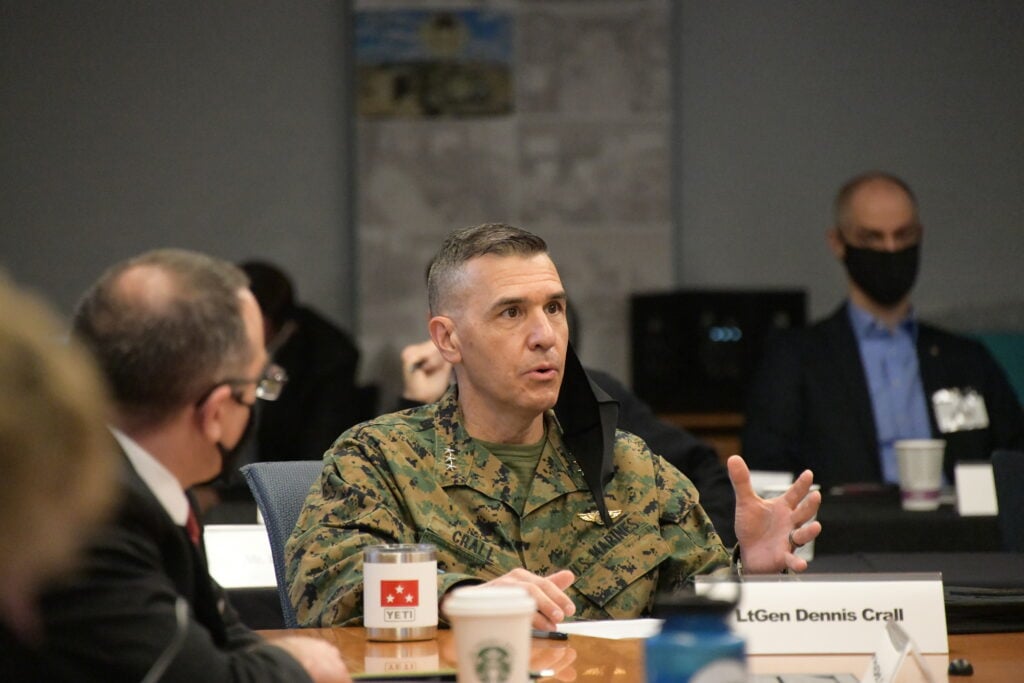By PAUL MCLEARY

WASHINGTON: The Joint All-Domain Command and Control (JADC2) strategy document could land on Defense Secretary Lloyd Austin’s desk within the next week, but the head of the Pentagon effort says huge hurdles remain to actually make it work.
Lt. Gen. Dennis Crall, who leads the Joint Staff’s J6 command and control directorate, said Tuesday the options being presented by industry for connecting far-flung forces have been lackluster. “I am looking for good enough and I have not found a good enough,” the Marine told an industry audience at an AFCEA event.
The draft JADC2 strategy is currently under review by Chairman of the Joint Chiefs of Staff Gen. Mark Milley. Developing common data standards, improving networking and opening up linkages to allies are key elements under the strategy.
Crall pointed to issues the services have when trying to communicate while deployed. For example, he said when a Marine leaves their home base workstation and embarks on a Navy ship as part of a Marine Expeditionary Unit, “it’s almost impossible to deliver an email, and we’re going to be doing processing on the edge and conclusion delivery to systems with a human in the middle of that decision-making apparatus. And this is a huge weakness,” Crall said.
The issues become particularly acute when the US wants to share data with members of the Five Eyes group, including Australia, Canada, New Zealand and the United Kingdom. The countries are considered America’s closest allies with whom the US would be expected to be able to communicate most easily.
The problems range across existing systems that will have to work with JADC2 to push data quickly from sensors to shooters everywhere from space to under the sea.
“I’ll be honest, I’ve listened to a lot of vendors, and I love hearing people that are excited to share their solutions,” he said. “I haven’t found any solutions that work.”
Asked if the solutions industry is offering were too complex, Crall said that he’s looking for basic technology that works: “I think maybe my tastes may have been on the high side before. Not any more. I think that I’m looking for good enough. And I’ve not found even good enough to be honest.”
The Pentagon plans on testing some JADC2 components with Five Eyes allies this fall, Crall said.
Other military officials at the conference also cautioned that some major policy and technological fixes need to happen before a real fusion of US and allied data sharing can happen.
Brig. Gen. Jeth Rey, CENTCOM’s director of command, control, communication and computer systems, said, “it truly comes down to adopting a policy and standards that really start at the releasable level,” an issue that the US has yet to fully grapple with.
“Unlike the current policies that build up from the US-only core of our networks, we really need to think about that releasable first,” Rey said Tuesday on a virtual panel at the AFCEA conference.
Indo-Pacific Command’s own J6 director, Brig. Gen. Jacqueline Brown, agreed that “policy is a significant concern…If we build a network, if we build these systems but they’re not releasable to our mission partners, we’re going to lose.”
The Joint Staff will experiment with exchanging some information with allies at the Bold Quest 21 experiment in September to test how quickly and accurately data can be pushed at distance, but it will be a long haul to reform policy and upgrade systems to do what the DoD wants to do. Bold Quest, held annually, is one of a series of Joint Staff “Coalition Capability Demonstration and Assessment” events.
Southern Command’s J6 head, Col. James Turinetti, added that it can take more than a year to get permission to share encrypted information with an ally. “Technically, we could solve it now. Equipment-wise we could solve it now,” he said. “As we work through the technology side, that doesn’t necessarily fix policy.”
No comments:
Post a Comment